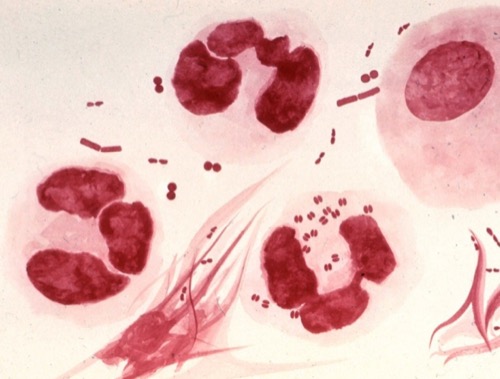You are here: Urology Textbook > Penis > Sexually transmitted diseases > Gonorrhea > Pathogen and symptoms
Gonorrhea: Pathogen and Symptoms of the gonococcal Urethritis
- Gonorrhea: Etiology, Signs and Symptoms
- Gonorrhea: Diagnosis and Treatment
Definition of Gonorrhea
Gonorrheal urethritis (GU) with purulent urethral discharge is a venereal disease caused by Neisseria gonorrhoeae. Gonorrhea is derived from an old Greek word meaning ‘flow of seed [semen]’.
Epidemiology of Gonorrhea
USA 114/100.000 new cases (in 2004), rising to nearly 200/100.000 (in 2021). Much lower figures in Europe, e.g., Germany 21/100.000 (in 2017).
Etiology of Gonorrhea
Bacterial pathogen:
Neisseria gonorrhoeae. Strictly aerobic. Unencapsulated.
Morphology of Gonococcus:
gram-negative diplococci with a diameter of about 1 micron (coffee bean-shaped). Frequently intracellular in granulocytes [fig. gonorrhea (microscopy)].
 |
Virulence factors:
There are pili for the attachment to human epithelial cells and secretion of proteins as virulence factors: porins, IgA-ase, and penicillinase. The contact of gonococci leads to endocytosis and basal exocytosis. This results in an infection of the urethral lamina propria.
Transmission of gonorrhea:
Gonorrhoea is a mucus membrane infection due to vaginal, oral or anal sexual contact. The risk of infection per intercourse for men is around 17%. Rare transmission occurs through birth or as aerosol infection (conjunctivitis). Humans are the only reservoir for Neisseria gonorrhoeae.
Gonorrhea: Signs and Symptoms
Urethritis:
The incubation period is 3–10 days, with a significant variance depending on the bacterial strain. Typical symptoms are purulent discharge from the urethra, dysuria, pain in the urethra, and inguinal lymphadenopathy. The extent of the symptoms is variable; women experience fewer symptoms than men.
Extragenital Infections:
Proctitis or pharyngitis causes only minor or no symptoms; these are relevant bacterial reservoirs. Conjunctivitis (ophthalmia neonatorum) is typical for neonates [fig. neonatal conjunctivitis]. Seldom arthritis or gonococcal sepsis.
Complications of Gonorrhea
Complications in men:
Acute prostatitis, epididymitis, urethral strictures, and infertility.
Complications in women:
Bartholinitis, cervical endometritis, pelvic inflammatory disease, and infertility.
Fitz-Hugh-Curtis syndrome:
Fitz-Hugh-Curtis syndrome is an ascending pelvic inflammatory disease with peritoneal infection. Typical is right-sided abdominal pain due to infection of the hepatic peritoneum (perihepatitis).
Reiter syndrome:
Due to a mixed infection with Chlamydia, the Reiter syndrome can also be possible in gonorrhea. See also chapter non-gonococcal urethritis.
| STD | Index | Gonorrhea Treatment |
Index: 1–9 A B C D E F G H I J K L M N O P Q R S T U V W X Y Z
References
CDC Guidelines: gonococcal infections in adolescents and adults. https://www.cdc.gov/std/treatment-guidelines/gonorrhea-adults.htm
EAU Guidelines "Urological Infections,” Available: https://uroweb.org/guidelines/urological-infections/.
IUSTI, Unemo et al.: European Guideline on the Diagnosis and Treatment of Gonorrhoea in Adults (2020). https://iusti.org/wp-content/uploads/2020/10/IUSTI-Gonorrhoea-2020.pdf
DSTIG, DGU, and RKI, “Diagnostik und Therapie der Gonorrhoe. AWMF S2k-Leitlinie,” 2018. [Online]. Available: https://www.awmf.org/uploads/tx_szleitlinien/059-004l_S2k_Gonorrhoe-Diagnostik-Therapie_2019-03.pdf.
Robert-Koch-Institut, “Gonorrhoe (Tripper): RKI Ratgeber,” 2023. [Online]. Available: https://www.rki.de/DE/Content/Infekt/EpidBull/Merkblaetter/Ratgeber_Gonorrhoe.html.
 Deutsche Version: Gonorrhoe: Erreger und Klinik gonorrhoischen Urethritis.
Deutsche Version: Gonorrhoe: Erreger und Klinik gonorrhoischen Urethritis.